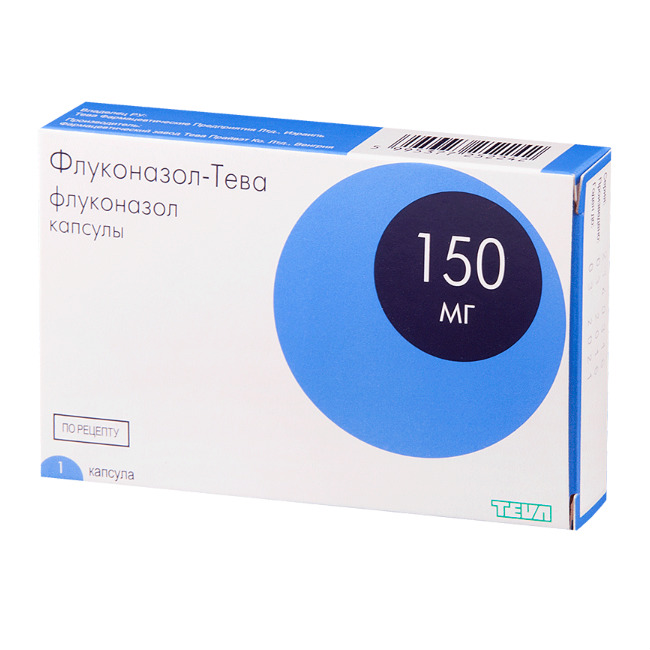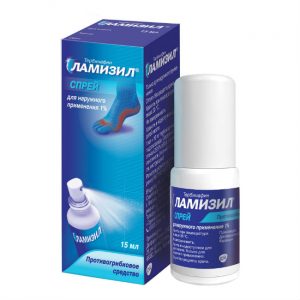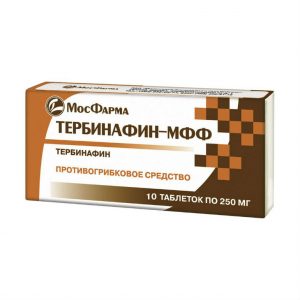Description
Release form
Capsules
Packing
1 pc
Indications srdlkol indicated for the treatment of the following diseases in adults: ² Ñ Cryptococcal meningitis.
² Ñ Coccidioidomycosis.
² Ñ Invasive candidiasis.
Mucosal candidiasis, including oropharyngeal candidiasis, oesophageal candidiasis, candiduria and chronic mucocutaneous candidiasis.
² Ñ Chronic atrophic oral candidiasis (associated with wearing dentures) when good oral hygiene or local treatment is not enough.
² Ñ Vaginal candidiasis, acute or recurring, when topical therapy is not applicable.
² Ñ Candidiasis balanitis when topical therapy is not applicable.
² Ñ Dermatomycosis, incl. dermatophytosis of the feet, dermatophytosis of the trunk, inguinal dermatophytosis, multi-colored lichen and skin candidiasis, when systemic treatment is indicated.
² Ñ Nail dermatophytosis (onychomycosis) when treatment with other drugs is not acceptable. Fluconazole is indicated for the prevention of the following diseases in adults: ² Ñ Relapses of cryptococcal meningitis in patients with a high risk of relapse.
² Ñ Relapses of oropharyngeal candidiasis and esophageal candidiasis in HIV-infected patients with a high risk of relapse.
² Ñ To reduce the recurrence rate of vaginal candidiasis (4 or more episodes per year).
² Ñ For the prevention of candidiasis infections in patients with prolonged neutropenia (such as patients with hemoblastoses undergoing chemotherapy or patients undergoing hematopoietic stem cell transplantation. Fluconazole is indicated for use in children.
Fluconazole is used to treat mucosal candidiasis and oropharyngeal candidiasis ), invasive candidiasis, cryptococcal meningitis and the prevention of candidal infections in patients with weakened immune systems. Fluconazole can be used as maintenance therapy to prevent the recurrence of cryptococcal meningitis in children at high risk of relapse
Contraindications
hypersensitivity to the drug (including a history of other azole antifungal drugs)
concurrent administration of terfenadine (with continuous administration of fluconazole at a dose of 400 mg / day or more) or astemizole, as well as other drugs, extending the QT
interval of children under 4 years of age.
Precautions: liver and / or renal failure, rash on the background of fluconazole in patients with superficial fungal infection and invasive / systemic fungal infections, concomitant use of terfenadine and fluconazole in a dose of less than 400 mg / day, concomitant use of potentially hepatotoxic drugs, alcoholism potentially proarrhythmogenic conditions in patients with multiple risk factors (organic heart disease, electrolyte imbalance, concomitant use of drugs that cause arrhythmias), pregnancy
Use during pregnancy and lactation
The use of the drug in pregnant women is impractical, with the exception of severe or life-threatening forms of fungal infections, when the potential benefits of fluconazole for the mother significantly exceed the risk to the fetus.
Since the concentration of fluconazole in breast milk and plasma is the same, it is contraindicated to use the drug during lactation.
Composition
1 capsule contains: Active ingredient fluconazole 150.00 mg
Excipients: lactose monohydrate 141.00 mg, corn starch 49.95 mg, colloidal silicon dioxide 0.3375 mg, sodium lauryl sulfate 0.3375 mg, magnesium stearate 3.375 mg.
Gelatin capsule: case: titanium dioxide (E171) 0.91 mg, diamond blue FCF (E133) 0.015 mg, gelatin qs up to 22.8 / qs up to 36.6 / qs up to 45.6 mg cap: titanium dioxide (E171) 0.61 mg, diamond blue FCF (E133) 0.010 mg, gelatin qs up to 15.2 / qs up to 24.4 / qs up to 30.4 mg
Dosage and administration
Inside. Capsules are swallowed whole.
Therapy can be started before the results of culture and other laboratory tests. However, antifungal therapy must be modified accordingly when the results of these studies become known.
When transferring a patient from intravenous to oral administration of the drug or vice versa, changes in the daily dose are not required. The daily dose of fluconazole depends on the nature and severity of the fungal infection. In case of infections requiring repeated administration of the drug, treatment should be continued until the clinical or laboratory signs of active fungal infection disappear. Patients with AIDS and cryptococcal meningitis or recurrent oropharyngeal candidiasis usually need supportive care to prevent recurrence of the infection.
Adult use of
1. For cryptococcal meningitis and cryptococcal infections of a different localization, a dose of 400 mg is usually used on the first day, and then treatment is continued at a dose of 200-400 mg once a day. The duration of treatment for cryptococcal infections depends on the presence of a clinical and mycological effect in cryptococcal meningitis, treatment usually lasts at least 6-8 weeks. In cases of treatment of life-threatening infections, the daily dose can be increased to 800 mg. To prevent relapse of cryptococcal meningitis in patients at high risk of relapse, after completing the full course of primary treatment, fluconazole therapy at a dose of 200 mg / day can be continued for an indefinite period of time.
2. With coccidioidomycosis, it may be necessary to use the drug in a dose of 200-400 mg / day. For some infections, especially those with damage to the meninges, a dose of 800 mg per day may be considered. The duration of therapy is determined individually, it can last up to 2 years and is 11-24 months with coccidioidomycosis, 2-17 months – with paracoccidioidomycosis, 1-16 months – with sporotrichosis and 3-17 months – with histoplasmosis.
3. For candidaemia, disseminated candidiasis, and other invasive candidiasis infections, the saturating dose is 800 mg on the first day, and the subsequent dose is 400 mg / day. The duration of therapy depends on clinical efficacy. The general recommendation for the duration of treatment for candidaemia is 2 weeks after the first negative result of blood culture and the disappearance of signs and symptoms of candidaemia.
4. Treatment of candidiasis of the mucous membrane.
With oropharyngeal candidiasis, the saturating dose: 200-400 mg on the first day, the subsequent dose: 100-200 mg once a day for 7-21 days. If necessary, patients with severe suppression of immune function can continue treatment for a longer time.
For chronic atrophic candidiasis of the oral cavity associated with wearing dentures, the drug is usually used at a dose of 50 mg once a day for 14 days in combination with local antiseptic agents for treating the prosthesis.
For candiduria, the effective dose is usually 200-400 mg / day with a treatment duration of 7-21 days. In patients with severely impaired immune system function, longer periods of therapy can be used.
For chronic mucocutaneous candidiasis, 50-100 mg per day is used up to 28 days of treatment. Depending on the severity of the course of the infection or a concomitant violation of the immune system and infection, longer periods of therapy can be used.
For esophageal candidiasis, a saturating dose of 200-400 mg on the first day, a subsequent dose of 100-200 mg per day. The course of treatment is 14-30 days (until remission of candidiasis of the esophagus is achieved). If necessary, patients with severe suppression of immune function can continue treatment for a longer time.
To prevent relapse of oropharyngeal candidiasis in HIV-infected patients with a high risk of relapse, fluconazole is used at 100-200 mg per day or 200 mg 3 times a week for an indefinite period of time in patients with chronically reduced immunity.
To prevent recurrence of esophageal candidiasis in HIV-infected patients with a high risk of recurrence, fluconazole is used at 100-200 mg per day or 200 mg 3 times a week for an indefinite period of time in patients with chronically reduced immunity.
5. In acute vaginal candidiasis, candida balanitis fluconazole is used once inside at a dose of 150 mg. To reduce the recurrence rate of vaginal candidiasis, the drug can be used in a dose of 150 mg every three days – only 3 doses (on the 1st, 4th and 7th day), then a maintenance dose of 150 mg once a week. A maintenance dose can be used up to 6 months.
6. Treatment of dermatomycosis
For skin infections, including foot dermatophytosis, trunk dermatophytosis, inguinal dermatophytosis, and candida infections, the recommended dose is 150 mg once a week or 50 mg once a day. The duration of therapy is usually 2-4 weeks, with mycosis of the feet a longer treatment may be required – up to 6 weeks.
For multi-colored lichen, the recommended dose is 300-400 mg once a week for 1-3 weeks. An alternative treatment regimen is the use of a drug of 50 mg once a day for 2-4 weeks.
For onychomycosis, the recommended dose is 150 mg once a week. Treatment should be continued until the replacement of the infected nail (growth of an uninfected nail). For repeated growth of nails on the fingers and toes, it usually takes 3-6 months and 6-12 months, respectively. However, the growth rate can vary widely among different people, as well as depending on age. After successful treatment of long-lasting chronic infections, a change in the shape of the nails is sometimes observed.
7. For the prevention of candidal infections in patients with prolonged neutropenia, the recommended dose of fluconazole is 200-400 mg once a day, depending on the risk of developing a fungal infection. For patients with a high risk of generalized infection, for example, with severe or persistent neutropenia, the recommended dose is 400 mg once a day. Fluconazole is used several days before the expected development of neutropenia and after an increase in the number of neutrophils more than 1000 in mm3, treatment is continued for another 7 days.
Use in children
As with similar infections in adults, the duration of treatment depends on the clinical and mycological effect. For children, the daily dose of the drug should not exceed that for adults.
Fluconazole is used daily once a day. With candidiasis of the mucous membranes, the recommended dose of fluconazole is 3 mg / kg / day. On the first day, in order to more quickly achieve equilibrium concentration, a loading dose of 6 mg / kg can be used.
For the treatment of invasive candidiasis and cryptococcal meningitis, the recommended dose is 6-12 mg / kg / day, depending on the severity of the disease.
To suppress relapse of cryptococcal meningitis in children with AIDS, the recommended dose of fluconazole is 6 mg / kg / day.
For the prevention of fungal infections in immunocompromised children whose risk of developing an infection is associated with neutropenia that develops as a result of cytotoxic chemotherapy or radiation therapy, the drug is used at 3-12 mg / kg / day, depending on the severity and duration of persistence of induced neutropenia ( see dose for adults for children with kidney failure – see dose for patients with kidney failure).
If it is not possible to correctly use the dosage form of fluconazole in capsule form in children, consider replacing it with other dosage forms of the drug (powder for oral suspension or solution for intravenous administration) in equivalent doses.
Use in the elderly
In the absence of signs of renal failure, fluconazole is used in the usual dose. In patients with renal failure (creatinine clearance <50 ml / min), the dose is adjusted as described below. Use in patients with renal failure. With a single dose dose adjustment is not required. In patients (including children) with impaired renal function with repeated use of the drug, an initial dose of 50 mg to 400 mg should be initially administered. after which the daily dose (depending on the indication) is set according to the following table: Creatinine clearance (ml / min) Recommended dose percentage > 50
? 50 (without dialysis) Regular dialysis 100%
50%
100% after each
dialysis Regular dialysis patients should receive 100% of the recommended dose after each dialysis session. On the day when dialysis is not performed, patients should receive a reduced (depending on creatinine clearance) dose of the drug.
In children with impaired renal function, the daily dose should be reduced (in the same proportional proportion as in adults), in accordance with the severity of renal failure.
Side effects of the
From the digestive system: decreased appetite, taste changes, abdominal pain, vomiting, nausea, diarrhea, flatulence, rarely – impaired liver function (jaundice, hepatitis, hepatonecrosis, hyperbilirubinemia, increased activity of alanine aminotransferase, aspartate aminotransferase, increased activity of alkaline phosphatase, hepatocellular necrosis), including heavy.
From the nervous system: headache, dizziness, excessive fatigue, rarely – cramps.
From the hemopoietic organs: rarely – leukopenia, thrombocytopenia (bleeding, petechiae), neutropenia, agranulocytosis.
Allergic reactions: skin rash, rarely erythema multiforme exudative (including Stevens-Johnson syndrome), toxic epidermal necrolysis (Lyell’s syndrome), anaphylactoid reactions (including angioedema, swelling of the face, urticaria, pruritus )
From the cardiovascular system: an increase in the duration of the QT interval, ventricular fibrillation / flutter.
Other: rarely – impaired renal function, alopecia, hypercholesterolemia, hypertriglyceridemia, hypokalemia.
Drug Interaction
Increases PV by an average of 12% when fluconazole is used with warfarin. In this regard, it is recommended to carefully monitor the parameters of PV in patients receiving the drug in combination with coumarin anticoagulants.
Fluconazole increases the plasma half-life of oral hypoglycemic agents – sulfonylurea (chlorpropamide, glibenclamide, glipizide, tolbutamide) derivatives in healthy people. Co-administration of fluconazole and oral hypoglycemic agents in patients with diabetes is permitted, but the physician should keep in mind the possibility of developing hypoglycemia.
Concomitant administration of Fluconazole and phenytoin may increase the plasma phenytoin concentration to a clinically relevant level. Therefore, if necessary, the co-administration of these drugs should monitor the concentration of phenytoin with dose adjustment in order to maintain the drug level within the therapeutic interval.
Combination with rifampicin results in a 25% decrease in AUC and a 20% reduction in the plasma half-life of fluconazole. Therefore, it is advisable to increase the dose of Fluconazole in patients receiving concomitant rifampicin.
It is recommended that blood levels of cyclosporine be monitored in patients receiving fluconazole, as they should be controlled. the use of fluconazole and cyclosporine in patients with a transplanted kidney (administration of Fluconazole at a dose of 200 mg / day) leads to a slow increase in the concentration of cyclosporine in plasma.
Patients receiving high doses of theophylline or who are likely to develop theophylline intoxication, should be monitored for early detection of symptoms of theophylline overdose, as fluconazole administration results in a decrease in the average clearance rate of theophylline from plasma.
When fluconazole is co-administered with terfenadine and cisapride, cardiac adverse events, including ventricular tachycardia (torsades de points), have been reported.
Concomitant administration of fluconazole and hydrochlorothiazide may increase plasma concentrations of fluconazole by 40%.
Fluconazole and rifabutin have been reported to be associated with increased serum levels of the latter. When fluconazole and rifabutin are co-administered, cases of uveitis have been reported. Patients receiving rifabutin and fluconazole should be closely monitored.
fluconazole administration results in a decrease in the average clearance rate of theophylline from plasma.
When fluconazole is co-administered with terfenadine and cisapride, cardiac adverse events, including ventricular tachycardia (torsades de points), have been reported.
Concomitant administration of fluconazole and hydrochlorothiazide may increase plasma concentrations of fluconazole by 40%.
Fluconazole and rifabutin have been reported to be associated with increased serum levels of the latter. When fluconazole and rifabutin are co-administered, cases of uveitis have been reported. Patients receiving rifabutin and fluconazole should be closely monitored.
fluconazole administration results in a decrease in the average clearance rate of theophylline from plasma.
When fluconazole is co-administered with terfenadine and cisapride, cardiac adverse events, including ventricular tachycardia (torsades de points), have been reported.
Concomitant administration of fluconazole and hydrochlorothiazide may increase plasma concentrations of fluconazole by 40%.
Fluconazole and rifabutin have been reported to be associated with increased serum levels of the latter. When fluconazole and rifabutin are co-administered, cases of uveitis have been reported. Patients receiving rifabutin and fluconazole should be closely monitored.
When fluconazole is co-administered with terfenadine and cisapride, cardiac adverse events, including ventricular tachycardia (torsades de points), have been reported.
Concomitant administration of fluconazole and hydrochlorothiazide may increase plasma concentrations of fluconazole by 40%.
Fluconazole and rifabutin have been reported to be associated with increased serum levels of the latter. When fluconazole and rifabutin are co-administered, cases of uveitis have been reported. Patients receiving rifabutin and fluconazole should be closely monitored.
When fluconazole is co-administered with terfenadine and cisapride, cardiac adverse events, including ventricular tachycardia (torsades de points), have been reported.
Concomitant administration of fluconazole and hydrochlorothiazide may increase plasma concentrations of fluconazole by 40%.
Fluconazole and rifabutin have been reported to be associated with increased serum levels of the latter. When fluconazole and rifabutin are co-administered, cases of uveitis have been reported. Patients receiving rifabutin and fluconazole should be closely monitored.
Fluconazole and rifabutin have been reported to be associated with increased serum levels of the latter. When fluconazole and rifabutin are co-administered, cases of uveitis have been reported. Patients receiving rifabutin and fluconazole should be closely monitored.
Fluconazole and rifabutin have been reported to be associated with increased serum levels of the latter. When fluconazole and rifabutin are co-administered, cases of uveitis have been reported. Patients receiving rifabutin and fluconazole should be closely monitored.
In patients receiving a combination of fluconazole and zidovudine, an increase in zidovudine concentration is observed, which is caused by a decrease in the latter’s conversion to its major metabolite, therefore, an increase in the side effects of zidovudine should be expected.
Increases the concentration of midazolam, which raises the risk of developing psychomotor effects (most pronounced when using fluconazole orally, rather than IV).
Increases tacrolimus concentration, thereby increasing the risk of nephrotoxicity.
Overdose
Symptoms: hallucinations, paranoid behavior.
Treatment: symptomatic – gastric lavage, forced diuresis. Hemodialysis reduces plasma concentrations by about 50% for 3 hours.
Storage conditions
In a dry, dark place at a temperature of 15 25 ° C.
Expiration
2 years
Deystvuyuschee substances
Fluconazole
dosage form
dosage form
capsules
Teva Pharmaceutical Enterprises Co., Ltd., Israel




